The Impact of Multinational Culture on Business Environment: A Comparative Study of Nepal, Vietnam, India, and Australia
VerifiedAdded on 2024/06/04
|12
|3289
|244
AI Summary
Contribute Materials
Your contribution can guide someone’s learning journey. Share your
documents today.
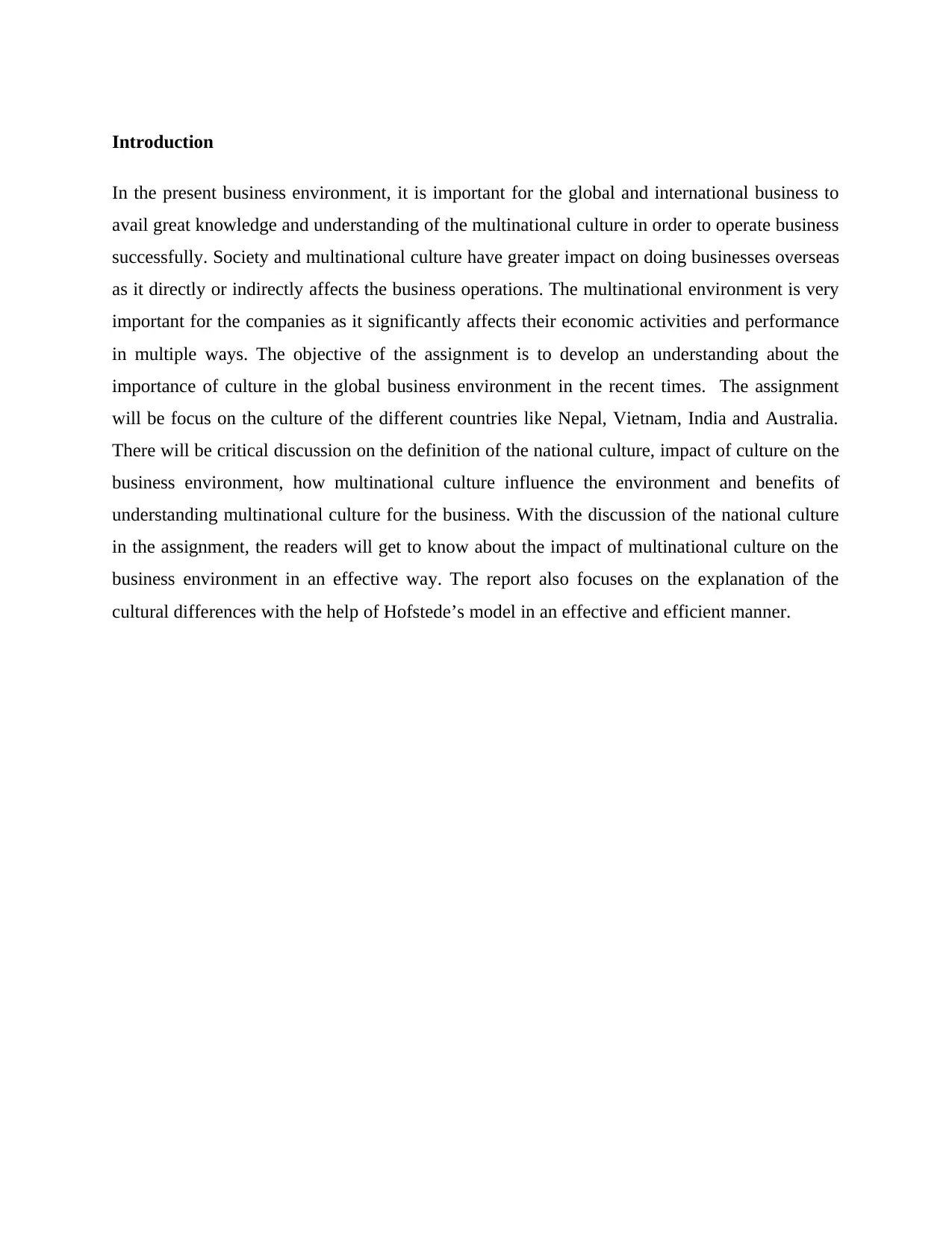
Introduction
In the present business environment, it is important for the global and international business to
avail great knowledge and understanding of the multinational culture in order to operate business
successfully. Society and multinational culture have greater impact on doing businesses overseas
as it directly or indirectly affects the business operations. The multinational environment is very
important for the companies as it significantly affects their economic activities and performance
in multiple ways. The objective of the assignment is to develop an understanding about the
importance of culture in the global business environment in the recent times. The assignment
will be focus on the culture of the different countries like Nepal, Vietnam, India and Australia.
There will be critical discussion on the definition of the national culture, impact of culture on the
business environment, how multinational culture influence the environment and benefits of
understanding multinational culture for the business. With the discussion of the national culture
in the assignment, the readers will get to know about the impact of multinational culture on the
business environment in an effective way. The report also focuses on the explanation of the
cultural differences with the help of Hofstede’s model in an effective and efficient manner.
In the present business environment, it is important for the global and international business to
avail great knowledge and understanding of the multinational culture in order to operate business
successfully. Society and multinational culture have greater impact on doing businesses overseas
as it directly or indirectly affects the business operations. The multinational environment is very
important for the companies as it significantly affects their economic activities and performance
in multiple ways. The objective of the assignment is to develop an understanding about the
importance of culture in the global business environment in the recent times. The assignment
will be focus on the culture of the different countries like Nepal, Vietnam, India and Australia.
There will be critical discussion on the definition of the national culture, impact of culture on the
business environment, how multinational culture influence the environment and benefits of
understanding multinational culture for the business. With the discussion of the national culture
in the assignment, the readers will get to know about the impact of multinational culture on the
business environment in an effective way. The report also focuses on the explanation of the
cultural differences with the help of Hofstede’s model in an effective and efficient manner.
Secure Best Marks with AI Grader
Need help grading? Try our AI Grader for instant feedback on your assignments.
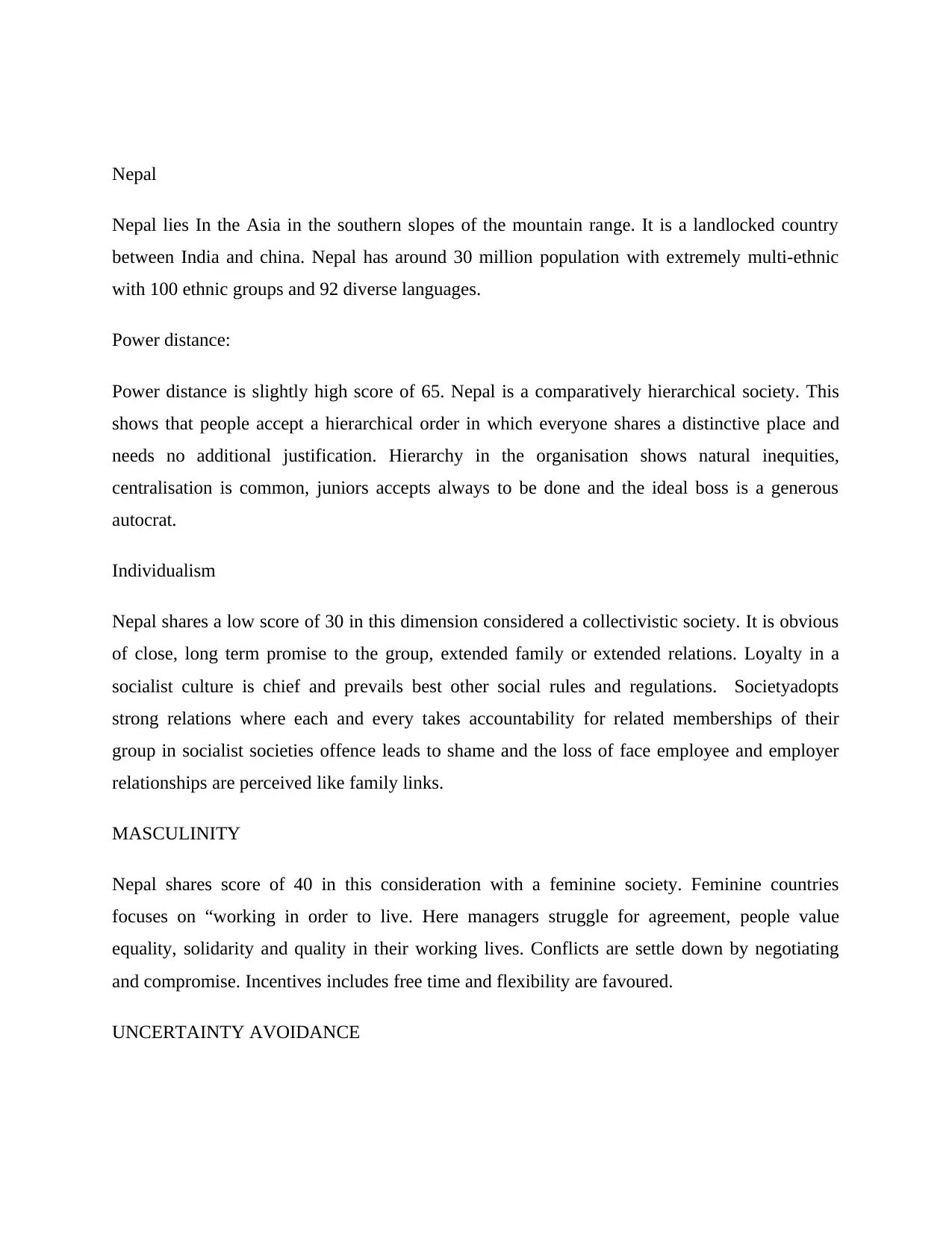
Nepal
Nepal lies In the Asia in the southern slopes of the mountain range. It is a landlocked country
between India and china. Nepal has around 30 million population with extremely multi-ethnic
with 100 ethnic groups and 92 diverse languages.
Power distance:
Power distance is slightly high score of 65. Nepal is a comparatively hierarchical society. This
shows that people accept a hierarchical order in which everyone shares a distinctive place and
needs no additional justification. Hierarchy in the organisation shows natural inequities,
centralisation is common, juniors accepts always to be done and the ideal boss is a generous
autocrat.
Individualism
Nepal shares a low score of 30 in this dimension considered a collectivistic society. It is obvious
of close, long term promise to the group, extended family or extended relations. Loyalty in a
socialist culture is chief and prevails best other social rules and regulations. Societyadopts
strong relations where each and every takes accountability for related memberships of their
group in socialist societies offence leads to shame and the loss of face employee and employer
relationships are perceived like family links.
MASCULINITY
Nepal shares score of 40 in this consideration with a feminine society. Feminine countries
focuses on “working in order to live. Here managers struggle for agreement, people value
equality, solidarity and quality in their working lives. Conflicts are settle down by negotiating
and compromise. Incentives includes free time and flexibility are favoured.
UNCERTAINTY AVOIDANCE
Nepal lies In the Asia in the southern slopes of the mountain range. It is a landlocked country
between India and china. Nepal has around 30 million population with extremely multi-ethnic
with 100 ethnic groups and 92 diverse languages.
Power distance:
Power distance is slightly high score of 65. Nepal is a comparatively hierarchical society. This
shows that people accept a hierarchical order in which everyone shares a distinctive place and
needs no additional justification. Hierarchy in the organisation shows natural inequities,
centralisation is common, juniors accepts always to be done and the ideal boss is a generous
autocrat.
Individualism
Nepal shares a low score of 30 in this dimension considered a collectivistic society. It is obvious
of close, long term promise to the group, extended family or extended relations. Loyalty in a
socialist culture is chief and prevails best other social rules and regulations. Societyadopts
strong relations where each and every takes accountability for related memberships of their
group in socialist societies offence leads to shame and the loss of face employee and employer
relationships are perceived like family links.
MASCULINITY
Nepal shares score of 40 in this consideration with a feminine society. Feminine countries
focuses on “working in order to live. Here managers struggle for agreement, people value
equality, solidarity and quality in their working lives. Conflicts are settle down by negotiating
and compromise. Incentives includes free time and flexibility are favoured.
UNCERTAINTY AVOIDANCE
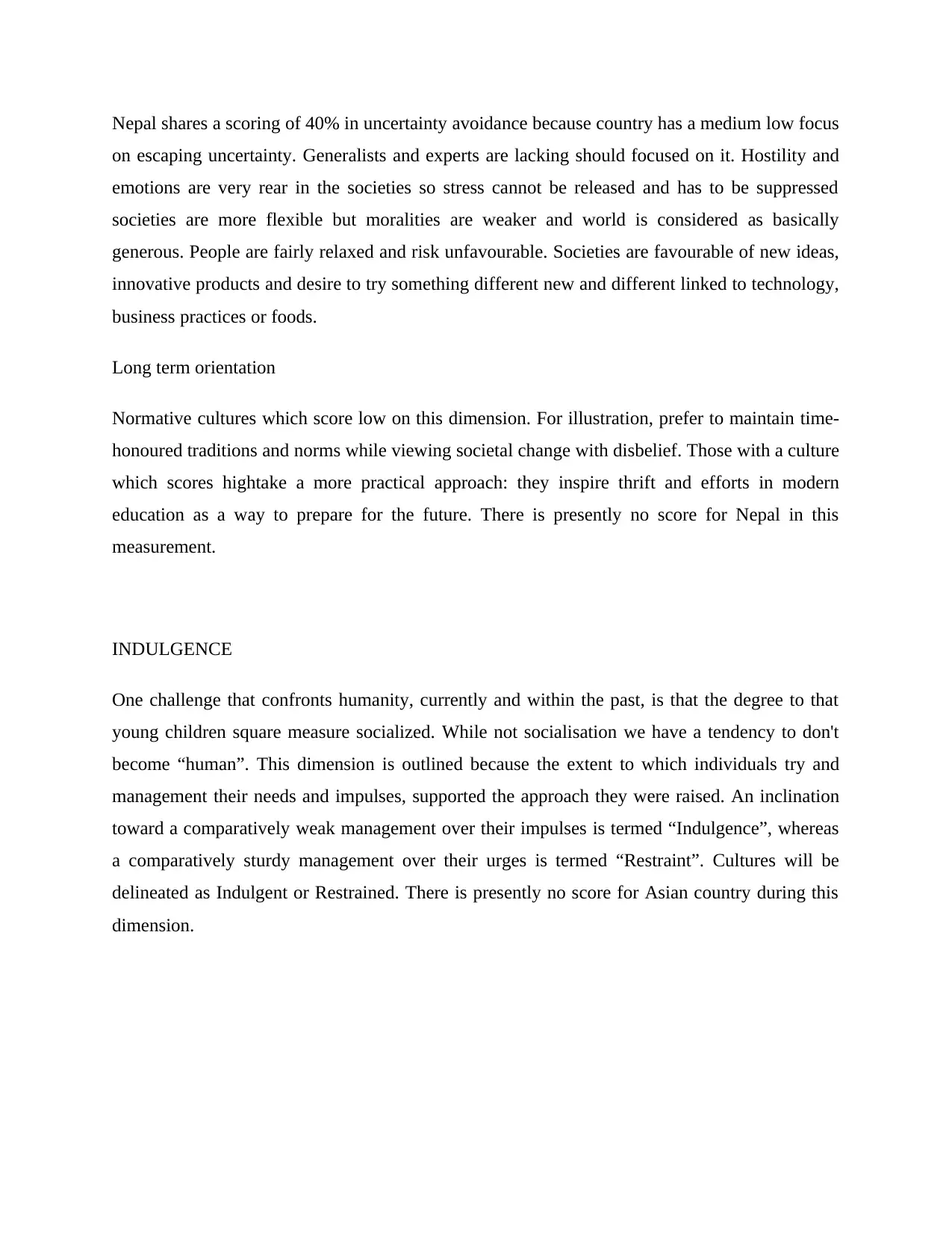
Nepal shares a scoring of 40% in uncertainty avoidance because country has a medium low focus
on escaping uncertainty. Generalists and experts are lacking should focused on it. Hostility and
emotions are very rear in the societies so stress cannot be released and has to be suppressed
societies are more flexible but moralities are weaker and world is considered as basically
generous. People are fairly relaxed and risk unfavourable. Societies are favourable of new ideas,
innovative products and desire to try something different new and different linked to technology,
business practices or foods.
Long term orientation
Normative cultures which score low on this dimension. For illustration, prefer to maintain time-
honoured traditions and norms while viewing societal change with disbelief. Those with a culture
which scores hightake a more practical approach: they inspire thrift and efforts in modern
education as a way to prepare for the future. There is presently no score for Nepal in this
measurement.
INDULGENCE
One challenge that confronts humanity, currently and within the past, is that the degree to that
young children square measure socialized. While not socialisation we have a tendency to don't
become “human”. This dimension is outlined because the extent to which individuals try and
management their needs and impulses, supported the approach they were raised. An inclination
toward a comparatively weak management over their impulses is termed “Indulgence”, whereas
a comparatively sturdy management over their urges is termed “Restraint”. Cultures will be
delineated as Indulgent or Restrained. There is presently no score for Asian country during this
dimension.
on escaping uncertainty. Generalists and experts are lacking should focused on it. Hostility and
emotions are very rear in the societies so stress cannot be released and has to be suppressed
societies are more flexible but moralities are weaker and world is considered as basically
generous. People are fairly relaxed and risk unfavourable. Societies are favourable of new ideas,
innovative products and desire to try something different new and different linked to technology,
business practices or foods.
Long term orientation
Normative cultures which score low on this dimension. For illustration, prefer to maintain time-
honoured traditions and norms while viewing societal change with disbelief. Those with a culture
which scores hightake a more practical approach: they inspire thrift and efforts in modern
education as a way to prepare for the future. There is presently no score for Nepal in this
measurement.
INDULGENCE
One challenge that confronts humanity, currently and within the past, is that the degree to that
young children square measure socialized. While not socialisation we have a tendency to don't
become “human”. This dimension is outlined because the extent to which individuals try and
management their needs and impulses, supported the approach they were raised. An inclination
toward a comparatively weak management over their impulses is termed “Indulgence”, whereas
a comparatively sturdy management over their urges is termed “Restraint”. Cultures will be
delineated as Indulgent or Restrained. There is presently no score for Asian country during this
dimension.
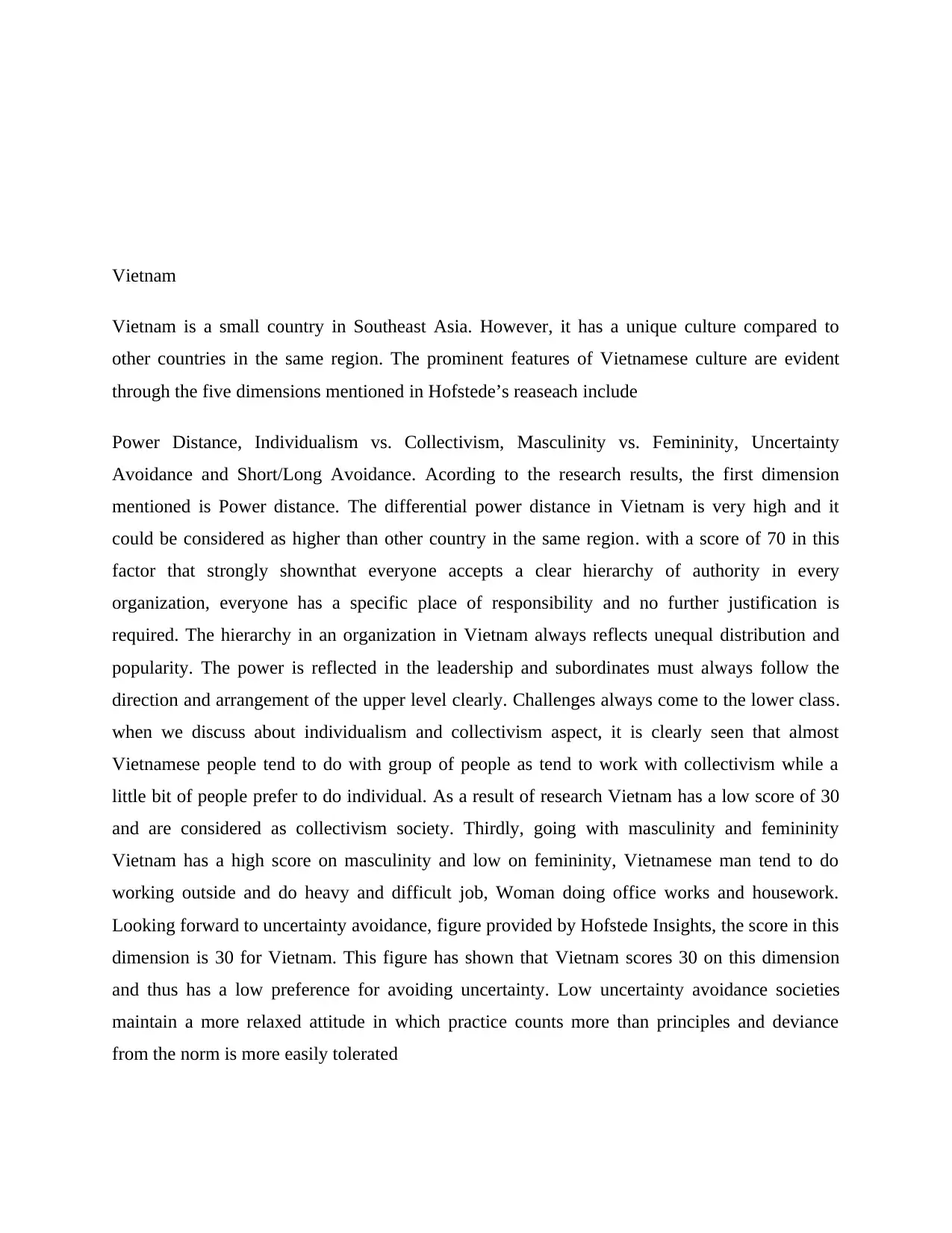
Vietnam
Vietnam is a small country in Southeast Asia. However, it has a unique culture compared to
other countries in the same region. The prominent features of Vietnamese culture are evident
through the five dimensions mentioned in Hofstede’s reaseach include
Power Distance, Individualism vs. Collectivism, Masculinity vs. Femininity, Uncertainty
Avoidance and Short/Long Avoidance. Acording to the research results, the first dimension
mentioned is Power distance. The differential power distance in Vietnam is very high and it
could be considered as higher than other country in the same region. with a score of 70 in this
factor that strongly shownthat everyone accepts a clear hierarchy of authority in every
organization, everyone has a specific place of responsibility and no further justification is
required. The hierarchy in an organization in Vietnam always reflects unequal distribution and
popularity. The power is reflected in the leadership and subordinates must always follow the
direction and arrangement of the upper level clearly. Challenges always come to the lower class.
when we discuss about individualism and collectivism aspect, it is clearly seen that almost
Vietnamese people tend to do with group of people as tend to work with collectivism while a
little bit of people prefer to do individual. As a result of research Vietnam has a low score of 30
and are considered as collectivism society. Thirdly, going with masculinity and femininity
Vietnam has a high score on masculinity and low on femininity, Vietnamese man tend to do
working outside and do heavy and difficult job, Woman doing office works and housework.
Looking forward to uncertainty avoidance, figure provided by Hofstede Insights, the score in this
dimension is 30 for Vietnam. This figure has shown that Vietnam scores 30 on this dimension
and thus has a low preference for avoiding uncertainty. Low uncertainty avoidance societies
maintain a more relaxed attitude in which practice counts more than principles and deviance
from the norm is more easily tolerated
Vietnam is a small country in Southeast Asia. However, it has a unique culture compared to
other countries in the same region. The prominent features of Vietnamese culture are evident
through the five dimensions mentioned in Hofstede’s reaseach include
Power Distance, Individualism vs. Collectivism, Masculinity vs. Femininity, Uncertainty
Avoidance and Short/Long Avoidance. Acording to the research results, the first dimension
mentioned is Power distance. The differential power distance in Vietnam is very high and it
could be considered as higher than other country in the same region. with a score of 70 in this
factor that strongly shownthat everyone accepts a clear hierarchy of authority in every
organization, everyone has a specific place of responsibility and no further justification is
required. The hierarchy in an organization in Vietnam always reflects unequal distribution and
popularity. The power is reflected in the leadership and subordinates must always follow the
direction and arrangement of the upper level clearly. Challenges always come to the lower class.
when we discuss about individualism and collectivism aspect, it is clearly seen that almost
Vietnamese people tend to do with group of people as tend to work with collectivism while a
little bit of people prefer to do individual. As a result of research Vietnam has a low score of 30
and are considered as collectivism society. Thirdly, going with masculinity and femininity
Vietnam has a high score on masculinity and low on femininity, Vietnamese man tend to do
working outside and do heavy and difficult job, Woman doing office works and housework.
Looking forward to uncertainty avoidance, figure provided by Hofstede Insights, the score in this
dimension is 30 for Vietnam. This figure has shown that Vietnam scores 30 on this dimension
and thus has a low preference for avoiding uncertainty. Low uncertainty avoidance societies
maintain a more relaxed attitude in which practice counts more than principles and deviance
from the norm is more easily tolerated
Secure Best Marks with AI Grader
Need help grading? Try our AI Grader for instant feedback on your assignments.
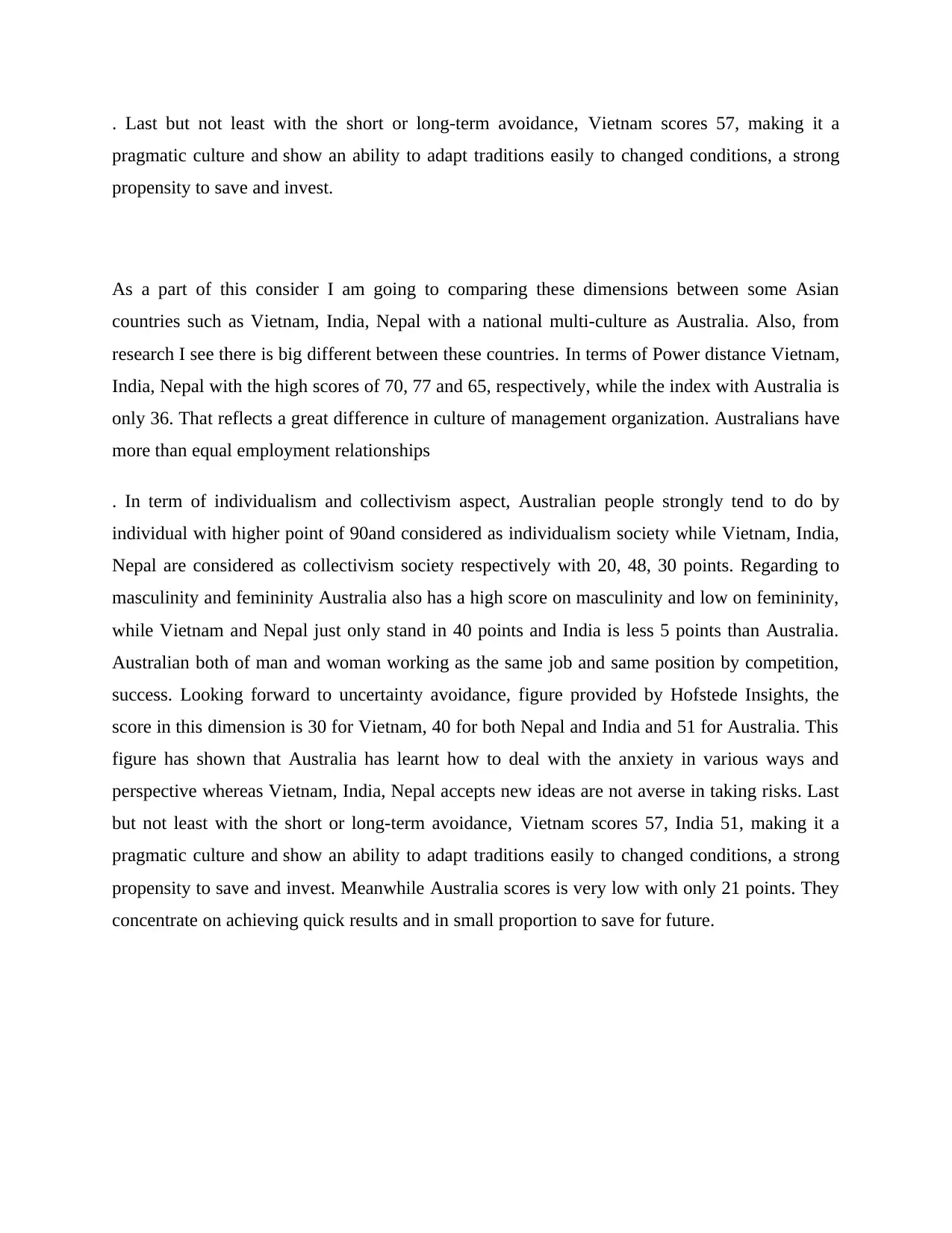
. Last but not least with the short or long-term avoidance, Vietnam scores 57, making it a
pragmatic culture and show an ability to adapt traditions easily to changed conditions, a strong
propensity to save and invest.
As a part of this consider I am going to comparing these dimensions between some Asian
countries such as Vietnam, India, Nepal with a national multi-culture as Australia. Also, from
research I see there is big different between these countries. In terms of Power distance Vietnam,
India, Nepal with the high scores of 70, 77 and 65, respectively, while the index with Australia is
only 36. That reflects a great difference in culture of management organization. Australians have
more than equal employment relationships
. In term of individualism and collectivism aspect, Australian people strongly tend to do by
individual with higher point of 90and considered as individualism society while Vietnam, India,
Nepal are considered as collectivism society respectively with 20, 48, 30 points. Regarding to
masculinity and femininity Australia also has a high score on masculinity and low on femininity,
while Vietnam and Nepal just only stand in 40 points and India is less 5 points than Australia.
Australian both of man and woman working as the same job and same position by competition,
success. Looking forward to uncertainty avoidance, figure provided by Hofstede Insights, the
score in this dimension is 30 for Vietnam, 40 for both Nepal and India and 51 for Australia. This
figure has shown that Australia has learnt how to deal with the anxiety in various ways and
perspective whereas Vietnam, India, Nepal accepts new ideas are not averse in taking risks. Last
but not least with the short or long-term avoidance, Vietnam scores 57, India 51, making it a
pragmatic culture and show an ability to adapt traditions easily to changed conditions, a strong
propensity to save and invest. Meanwhile Australia scores is very low with only 21 points. They
concentrate on achieving quick results and in small proportion to save for future.
pragmatic culture and show an ability to adapt traditions easily to changed conditions, a strong
propensity to save and invest.
As a part of this consider I am going to comparing these dimensions between some Asian
countries such as Vietnam, India, Nepal with a national multi-culture as Australia. Also, from
research I see there is big different between these countries. In terms of Power distance Vietnam,
India, Nepal with the high scores of 70, 77 and 65, respectively, while the index with Australia is
only 36. That reflects a great difference in culture of management organization. Australians have
more than equal employment relationships
. In term of individualism and collectivism aspect, Australian people strongly tend to do by
individual with higher point of 90and considered as individualism society while Vietnam, India,
Nepal are considered as collectivism society respectively with 20, 48, 30 points. Regarding to
masculinity and femininity Australia also has a high score on masculinity and low on femininity,
while Vietnam and Nepal just only stand in 40 points and India is less 5 points than Australia.
Australian both of man and woman working as the same job and same position by competition,
success. Looking forward to uncertainty avoidance, figure provided by Hofstede Insights, the
score in this dimension is 30 for Vietnam, 40 for both Nepal and India and 51 for Australia. This
figure has shown that Australia has learnt how to deal with the anxiety in various ways and
perspective whereas Vietnam, India, Nepal accepts new ideas are not averse in taking risks. Last
but not least with the short or long-term avoidance, Vietnam scores 57, India 51, making it a
pragmatic culture and show an ability to adapt traditions easily to changed conditions, a strong
propensity to save and invest. Meanwhile Australia scores is very low with only 21 points. They
concentrate on achieving quick results and in small proportion to save for future.
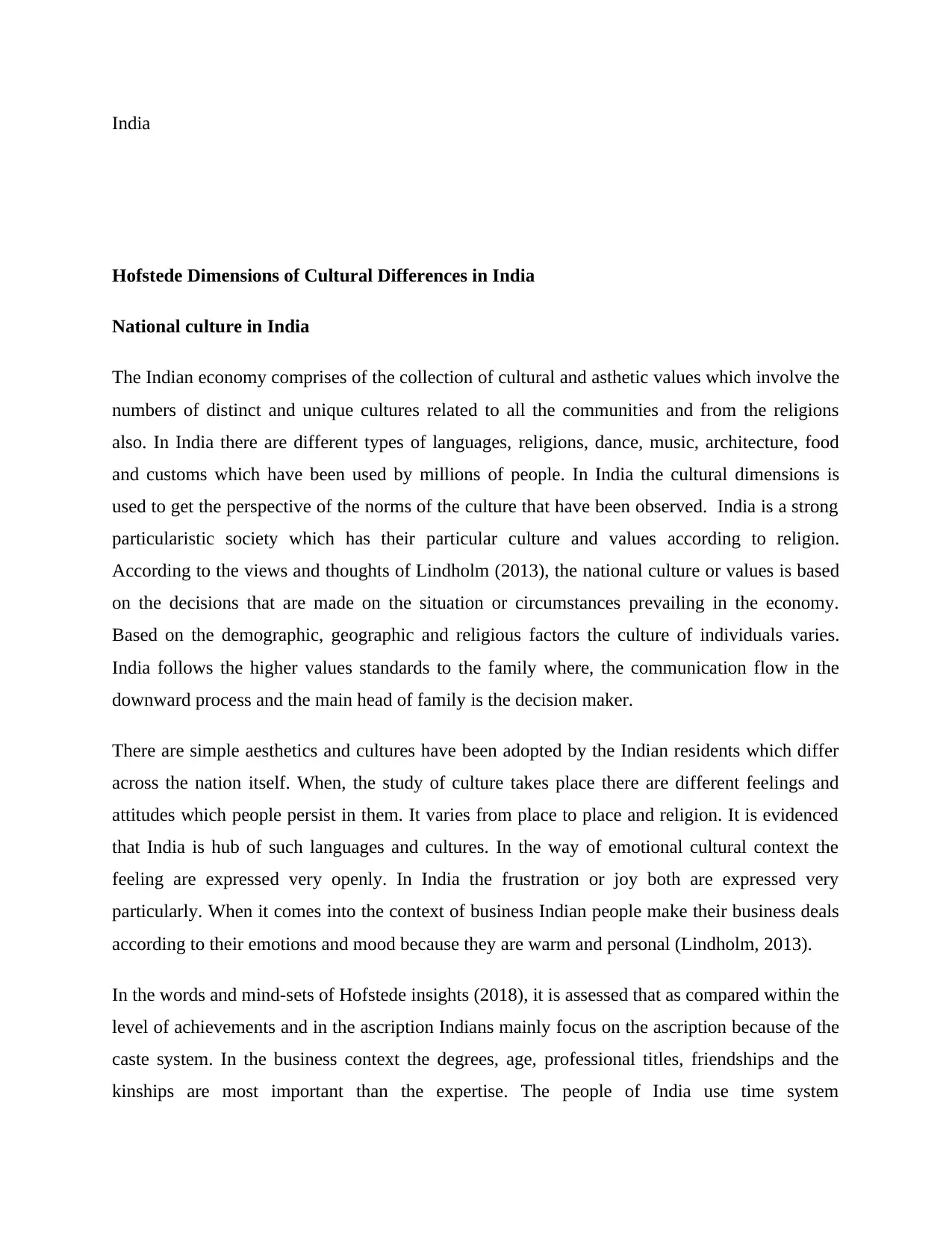
India
Hofstede Dimensions of Cultural Differences in India
National culture in India
The Indian economy comprises of the collection of cultural and asthetic values which involve the
numbers of distinct and unique cultures related to all the communities and from the religions
also. In India there are different types of languages, religions, dance, music, architecture, food
and customs which have been used by millions of people. In India the cultural dimensions is
used to get the perspective of the norms of the culture that have been observed. India is a strong
particularistic society which has their particular culture and values according to religion.
According to the views and thoughts of Lindholm (2013), the national culture or values is based
on the decisions that are made on the situation or circumstances prevailing in the economy.
Based on the demographic, geographic and religious factors the culture of individuals varies.
India follows the higher values standards to the family where, the communication flow in the
downward process and the main head of family is the decision maker.
There are simple aesthetics and cultures have been adopted by the Indian residents which differ
across the nation itself. When, the study of culture takes place there are different feelings and
attitudes which people persist in them. It varies from place to place and religion. It is evidenced
that India is hub of such languages and cultures. In the way of emotional cultural context the
feeling are expressed very openly. In India the frustration or joy both are expressed very
particularly. When it comes into the context of business Indian people make their business deals
according to their emotions and mood because they are warm and personal (Lindholm, 2013).
In the words and mind-sets of Hofstede insights (2018), it is assessed that as compared within the
level of achievements and in the ascription Indians mainly focus on the ascription because of the
caste system. In the business context the degrees, age, professional titles, friendships and the
kinships are most important than the expertise. The people of India use time system
Hofstede Dimensions of Cultural Differences in India
National culture in India
The Indian economy comprises of the collection of cultural and asthetic values which involve the
numbers of distinct and unique cultures related to all the communities and from the religions
also. In India there are different types of languages, religions, dance, music, architecture, food
and customs which have been used by millions of people. In India the cultural dimensions is
used to get the perspective of the norms of the culture that have been observed. India is a strong
particularistic society which has their particular culture and values according to religion.
According to the views and thoughts of Lindholm (2013), the national culture or values is based
on the decisions that are made on the situation or circumstances prevailing in the economy.
Based on the demographic, geographic and religious factors the culture of individuals varies.
India follows the higher values standards to the family where, the communication flow in the
downward process and the main head of family is the decision maker.
There are simple aesthetics and cultures have been adopted by the Indian residents which differ
across the nation itself. When, the study of culture takes place there are different feelings and
attitudes which people persist in them. It varies from place to place and religion. It is evidenced
that India is hub of such languages and cultures. In the way of emotional cultural context the
feeling are expressed very openly. In India the frustration or joy both are expressed very
particularly. When it comes into the context of business Indian people make their business deals
according to their emotions and mood because they are warm and personal (Lindholm, 2013).
In the words and mind-sets of Hofstede insights (2018), it is assessed that as compared within the
level of achievements and in the ascription Indians mainly focus on the ascription because of the
caste system. In the business context the degrees, age, professional titles, friendships and the
kinships are most important than the expertise. The people of India use time system
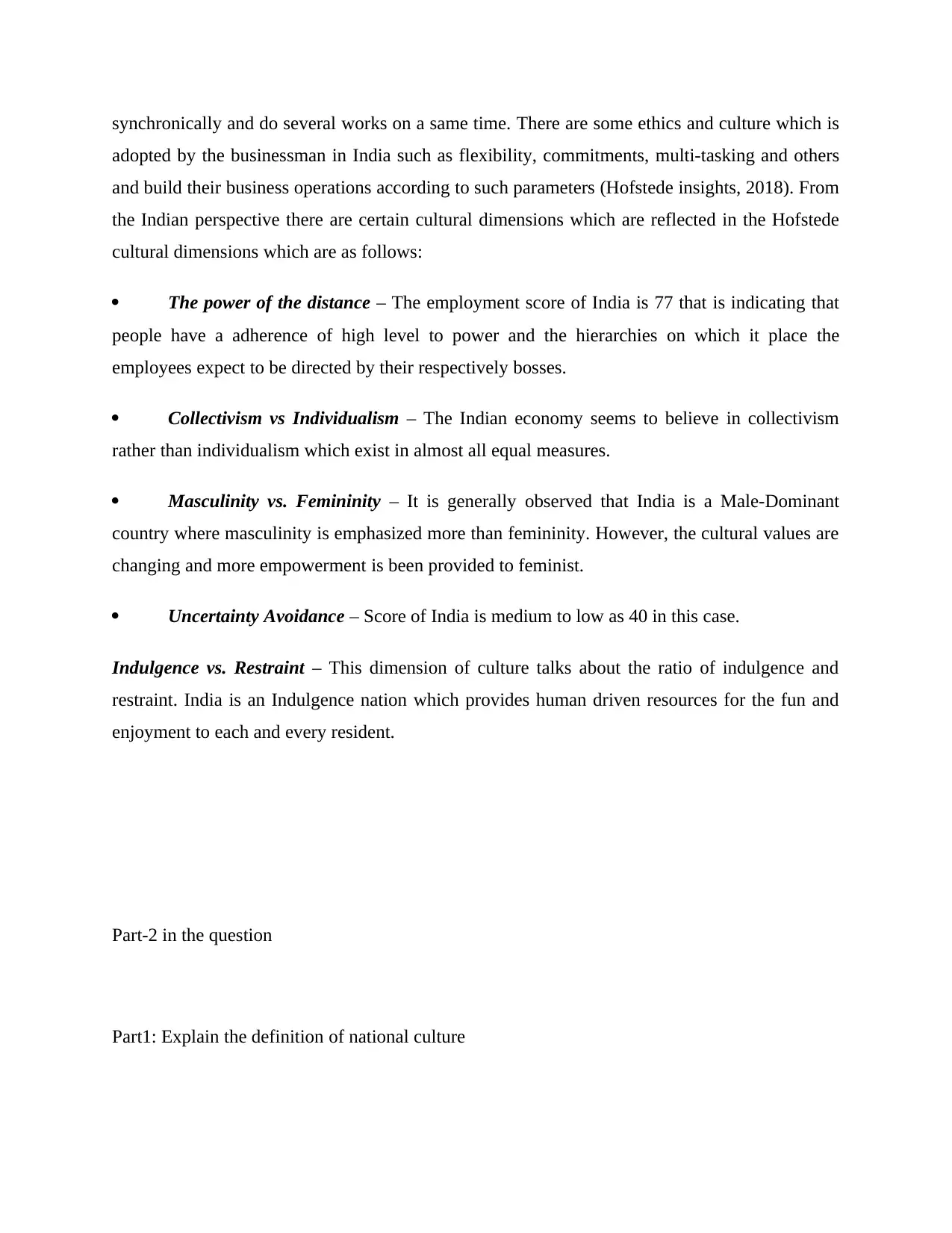
synchronically and do several works on a same time. There are some ethics and culture which is
adopted by the businessman in India such as flexibility, commitments, multi-tasking and others
and build their business operations according to such parameters (Hofstede insights, 2018). From
the Indian perspective there are certain cultural dimensions which are reflected in the Hofstede
cultural dimensions which are as follows:
The power of the distance – The employment score of India is 77 that is indicating that
people have a adherence of high level to power and the hierarchies on which it place the
employees expect to be directed by their respectively bosses.
Collectivism vs Individualism – The Indian economy seems to believe in collectivism
rather than individualism which exist in almost all equal measures.
Masculinity vs. Femininity – It is generally observed that India is a Male-Dominant
country where masculinity is emphasized more than femininity. However, the cultural values are
changing and more empowerment is been provided to feminist.
Uncertainty Avoidance – Score of India is medium to low as 40 in this case.
Indulgence vs. Restraint – This dimension of culture talks about the ratio of indulgence and
restraint. India is an Indulgence nation which provides human driven resources for the fun and
enjoyment to each and every resident.
Part-2 in the question
Part1: Explain the definition of national culture
adopted by the businessman in India such as flexibility, commitments, multi-tasking and others
and build their business operations according to such parameters (Hofstede insights, 2018). From
the Indian perspective there are certain cultural dimensions which are reflected in the Hofstede
cultural dimensions which are as follows:
The power of the distance – The employment score of India is 77 that is indicating that
people have a adherence of high level to power and the hierarchies on which it place the
employees expect to be directed by their respectively bosses.
Collectivism vs Individualism – The Indian economy seems to believe in collectivism
rather than individualism which exist in almost all equal measures.
Masculinity vs. Femininity – It is generally observed that India is a Male-Dominant
country where masculinity is emphasized more than femininity. However, the cultural values are
changing and more empowerment is been provided to feminist.
Uncertainty Avoidance – Score of India is medium to low as 40 in this case.
Indulgence vs. Restraint – This dimension of culture talks about the ratio of indulgence and
restraint. India is an Indulgence nation which provides human driven resources for the fun and
enjoyment to each and every resident.
Part-2 in the question
Part1: Explain the definition of national culture
Paraphrase This Document
Need a fresh take? Get an instant paraphrase of this document with our AI Paraphraser

The country could be consider as a multinational culture when it has more than one national
culture and each must be has different unique factor. Each national culture presents on behalf of
each country so understanding multinational culture becoming the most important thing on
operating the business nowadays. Multinational defined by its values, assumptions and beliefs.
Because ofthe diverse characteristics of the culture, developed nations today rely on it to guide
the development of the economy. Multiculturalism creates many opportunities for new directions
for business development. The combination of cultures forms a solid foundation in
communication, a common tool in economic development. Each bearing brings to its own
identity and has a permanent value in itself.Businesses seek to understand more deeply the
tendencies of individual cultures and then to come up with effective business strategies.
Developing in a multicultural country is always accompanied by challenges. Businesses are
constantly confronted with cultural differences and this is one of the challenges. There is no
doubt that Multinational country, organisation are facing more challenges when they try to
develop a cohesive organizational culture than single culture
Part2: how multinational culture playas important role in business environment
Multinational culture plays important role in the business environment due to the rapid
advancement of the technologies, labor cost factor, trade agreements, methods of distribution. A
number of large and multinational organizations are going global for their business expansion
through different ways. As with the integration of the multiple cultures, the operations of the
business organizations are affected in multiple ways. In the cases of the international expansion
of the businesses, it takes time to adopt the new culture and traits. It can be said that merger or
acquisition of the established company is better way to expand the business internationally as the
parent company is aware about the beliefs and norms of the company and they can adapt to its
culture easily. On the flow of the business, cultural factors have a stronger impact as each
country has its own language, religion, beliefs, attitude, manners and the adaptation of a foreign
company on these elements is a challenging task. People in multi-cultural business environment
cannot find it easy to connect and interact with the people from different culture and background
culture and each must be has different unique factor. Each national culture presents on behalf of
each country so understanding multinational culture becoming the most important thing on
operating the business nowadays. Multinational defined by its values, assumptions and beliefs.
Because ofthe diverse characteristics of the culture, developed nations today rely on it to guide
the development of the economy. Multiculturalism creates many opportunities for new directions
for business development. The combination of cultures forms a solid foundation in
communication, a common tool in economic development. Each bearing brings to its own
identity and has a permanent value in itself.Businesses seek to understand more deeply the
tendencies of individual cultures and then to come up with effective business strategies.
Developing in a multicultural country is always accompanied by challenges. Businesses are
constantly confronted with cultural differences and this is one of the challenges. There is no
doubt that Multinational country, organisation are facing more challenges when they try to
develop a cohesive organizational culture than single culture
Part2: how multinational culture playas important role in business environment
Multinational culture plays important role in the business environment due to the rapid
advancement of the technologies, labor cost factor, trade agreements, methods of distribution. A
number of large and multinational organizations are going global for their business expansion
through different ways. As with the integration of the multiple cultures, the operations of the
business organizations are affected in multiple ways. In the cases of the international expansion
of the businesses, it takes time to adopt the new culture and traits. It can be said that merger or
acquisition of the established company is better way to expand the business internationally as the
parent company is aware about the beliefs and norms of the company and they can adapt to its
culture easily. On the flow of the business, cultural factors have a stronger impact as each
country has its own language, religion, beliefs, attitude, manners and the adaptation of a foreign
company on these elements is a challenging task. People in multi-cultural business environment
cannot find it easy to connect and interact with the people from different culture and background

that lead to the creation of problem for the development and growth of the overall business
organization. Understanding the cultural differences with respect, sensitivity and responsibility
not only helps in doing international business with greater ease and flexibility but also connects
people and nations together. This type of multicultural environment promotes excellence and
leads to the growth of the business organizations internationally (Moore, 2016).
Part3: what are the impacts of multinational culture in business environment?
In the present times, the business conducted by the global companies has brought the people
from multinational culture together in the business environment that greatly influences the
businesses. Multinational culture has both positive as well as negative implications on the
business environment. When people from different culture works together, it brings out the best
ideas and opinions that results in the successful accomplishment of the organizational goals and
objectives and develop a sustainable business environment. Cultural diversity at work helps them
people towards their work and achievement. The implication of the multinational culture on the
operations of the businesses is widespread where the business sometimes faces the negative
consequences due to the differences in the cultural perception of the individuals. The business
environment is also influenced when a multinational company establishes its corporate culture on
the basis of the cultural differences already existing in the countries where it operates. It brings
out number of changes in the existing business environment of the country which might affects
the domestic businesses of the country in some ways. Hence it can be said multinational culture
directly or indirectly affect the business environment and makes it challenging for the
multinational owners and managers to manage the business with greater ease and flexibility. It is
essential for the multinational companies to learn and investigate the business environment of the
particular country in order to avail the advantages of the opportunities and manage the threats in
an efficient manner (Kotabe & Helsen, 2014).
Part 4: what are the benefits of understanding multinational culture for busimness?
organization. Understanding the cultural differences with respect, sensitivity and responsibility
not only helps in doing international business with greater ease and flexibility but also connects
people and nations together. This type of multicultural environment promotes excellence and
leads to the growth of the business organizations internationally (Moore, 2016).
Part3: what are the impacts of multinational culture in business environment?
In the present times, the business conducted by the global companies has brought the people
from multinational culture together in the business environment that greatly influences the
businesses. Multinational culture has both positive as well as negative implications on the
business environment. When people from different culture works together, it brings out the best
ideas and opinions that results in the successful accomplishment of the organizational goals and
objectives and develop a sustainable business environment. Cultural diversity at work helps them
people towards their work and achievement. The implication of the multinational culture on the
operations of the businesses is widespread where the business sometimes faces the negative
consequences due to the differences in the cultural perception of the individuals. The business
environment is also influenced when a multinational company establishes its corporate culture on
the basis of the cultural differences already existing in the countries where it operates. It brings
out number of changes in the existing business environment of the country which might affects
the domestic businesses of the country in some ways. Hence it can be said multinational culture
directly or indirectly affect the business environment and makes it challenging for the
multinational owners and managers to manage the business with greater ease and flexibility. It is
essential for the multinational companies to learn and investigate the business environment of the
particular country in order to avail the advantages of the opportunities and manage the threats in
an efficient manner (Kotabe & Helsen, 2014).
Part 4: what are the benefits of understanding multinational culture for busimness?
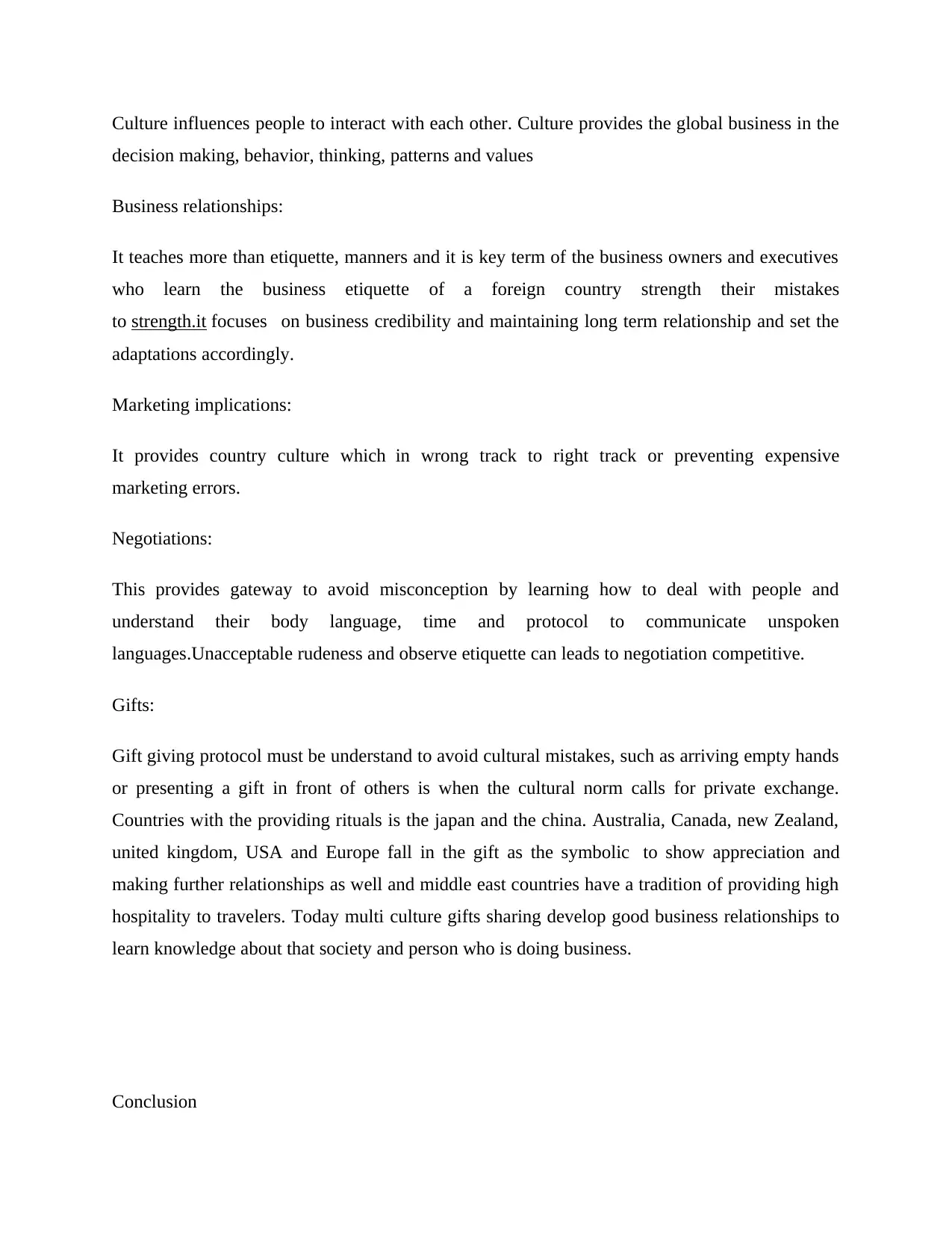
Culture influences people to interact with each other. Culture provides the global business in the
decision making, behavior, thinking, patterns and values
Business relationships:
It teaches more than etiquette, manners and it is key term of the business owners and executives
who learn the business etiquette of a foreign country strength their mistakes
to strength.it focuses on business credibility and maintaining long term relationship and set the
adaptations accordingly.
Marketing implications:
It provides country culture which in wrong track to right track or preventing expensive
marketing errors.
Negotiations:
This provides gateway to avoid misconception by learning how to deal with people and
understand their body language, time and protocol to communicate unspoken
languages.Unacceptable rudeness and observe etiquette can leads to negotiation competitive.
Gifts:
Gift giving protocol must be understand to avoid cultural mistakes, such as arriving empty hands
or presenting a gift in front of others is when the cultural norm calls for private exchange.
Countries with the providing rituals is the japan and the china. Australia, Canada, new Zealand,
united kingdom, USA and Europe fall in the gift as the symbolic to show appreciation and
making further relationships as well and middle east countries have a tradition of providing high
hospitality to travelers. Today multi culture gifts sharing develop good business relationships to
learn knowledge about that society and person who is doing business.
Conclusion
decision making, behavior, thinking, patterns and values
Business relationships:
It teaches more than etiquette, manners and it is key term of the business owners and executives
who learn the business etiquette of a foreign country strength their mistakes
to strength.it focuses on business credibility and maintaining long term relationship and set the
adaptations accordingly.
Marketing implications:
It provides country culture which in wrong track to right track or preventing expensive
marketing errors.
Negotiations:
This provides gateway to avoid misconception by learning how to deal with people and
understand their body language, time and protocol to communicate unspoken
languages.Unacceptable rudeness and observe etiquette can leads to negotiation competitive.
Gifts:
Gift giving protocol must be understand to avoid cultural mistakes, such as arriving empty hands
or presenting a gift in front of others is when the cultural norm calls for private exchange.
Countries with the providing rituals is the japan and the china. Australia, Canada, new Zealand,
united kingdom, USA and Europe fall in the gift as the symbolic to show appreciation and
making further relationships as well and middle east countries have a tradition of providing high
hospitality to travelers. Today multi culture gifts sharing develop good business relationships to
learn knowledge about that society and person who is doing business.
Conclusion
Secure Best Marks with AI Grader
Need help grading? Try our AI Grader for instant feedback on your assignments.

It is concluded from the assignment that culture plays important role in the global business
environment. It is important to have notable information about the national culture of the
different countries so as to run a business successfully in a foreign country. The assignment has
presented the knowledge about significant importance of national culture in the global business
environment. From the perspectives of the multinational companies, lack of knowledge about the
culture of the countries in which they operate creates lot of opportunities and new directions for
the continuous growth and business development. The multinational companies should
implement the strategies and programs in order to cop up and adjust in the global business
environment with greater ease and flexibility.
References
environment. It is important to have notable information about the national culture of the
different countries so as to run a business successfully in a foreign country. The assignment has
presented the knowledge about significant importance of national culture in the global business
environment. From the perspectives of the multinational companies, lack of knowledge about the
culture of the countries in which they operate creates lot of opportunities and new directions for
the continuous growth and business development. The multinational companies should
implement the strategies and programs in order to cop up and adjust in the global business
environment with greater ease and flexibility.
References

Moore, F. (2016). Transnational business cultures: Life and work in a multinational corporation.
Routledge.
Kotabe, M., & Helsen, K. (2014). Global marketing management.
Routledge.
Kotabe, M., & Helsen, K. (2014). Global marketing management.
1 out of 12
Related Documents
Your All-in-One AI-Powered Toolkit for Academic Success.
+13062052269
info@desklib.com
Available 24*7 on WhatsApp / Email
![[object Object]](/_next/static/media/star-bottom.7253800d.svg)
Unlock your academic potential
© 2024 | Zucol Services PVT LTD | All rights reserved.




